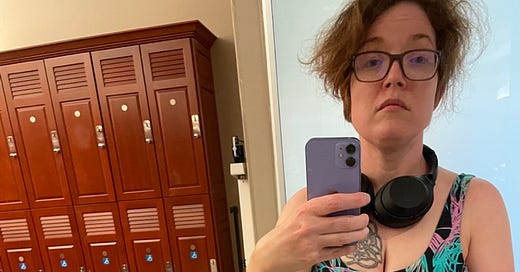I don’t know how old I was when I accepted the fact that everyone can see my disability, cerebral palsy, and that it will never go away, but I wasn’t young. I’d gone through activist phases in college, but they only went so deep: the fact was, no amount of compliments, male attention, feminist manifestos, or sporadic nights of traffic-stopping makeovers actually got me comfortable with looking at the way I walked. Ecstatic Dance, which is basically freeform movement to music chosen by a cosmically-minded instructor who in this case was basically a DJ because there are no rules, was a religious practice for me when I lived in Austin, and the class’s guide would cover up the mirrors. The covered mirrors were the only reason I was comfortable dancing freely in front of other people. It was a fearlessly embodied practice, but I ultimately did it for the visions: something about the relaxed non-judgemental rulelessness of gliding across the floor without holding onto anything, or knowing I was free to slide down onto it and roll around or lie still, made me see things in my mind’s eye that felt truly epiphanic at the time. I would often share these visions at the end of class when we had an opportunity to discuss our experiences in a circle, and ultimately, everybody in that class loved me for the same reason I’ve always been loved: I spin a damn good phrase, and I do it with warmth. Words and mind, that’s what I’m good for. Being loved for my body? I was afraid of that.
There are a lot of reasons I was afraid, and not all of them are strictly related to being born with a physical disability. As a teenager, my mom and her youngest sister often told me I had the figure of Barbie, which is a really creepy thing to tell your petite large-chested daughter, but I’ll leave you with that for the moment, quietly creeped out, I assume. (Apologies.) In the last two years, I’ve discovered that wildly irrational fears drive most of the anxiety I feel: subconscious thoughts like, “What if the flat road suddenly rose up into a gigantic hill and kept rising, and it threw the car, what would we do?” (As I write that all out now, this sounds like a simple case of a New Orleans-born sub-sealevel child never having adjusted to San Francisco’s hills.) For countless reasons, and I use that word deliberately because I’m trying to count them in therapy and we’re still going, I felt out of control in my body. My body was this out of control thing. It didn’t do what I wanted it to do.
These days it kind of does, because I’ve come to accept that for whatever duration I’ve got on this fucked-beautiful planet, this is the body I’ll be existing in. I can do a lot more than my disability-designation often compelled me to assume I could do. I can lift a lot more with my abs than I knew I was capable of, I can keep my knees apart when I squat if I focus. A lot of focus is involved, but I’m getting less resentful about that. There’s nothing wrong with paying attention, and too many people don’t.
In this newsletter, I plan to document the weird shit people say to me on the street, driven by assumptions about my body that they are certain are facts. At this moment, I don’t want to backtrack: suffice to say it happens so hilariously often that sharing it with my intimate circles is not enough. Too many people are shocked by my stories before I get to the shocking part, and that shows me there’s a whole lot of ignorance out there about what normal life entails for visibly disabled people. I’d like to do my part to mitigate this ignorance. And no matter how knowledgeable you are, I’d love to have you along for the ride



